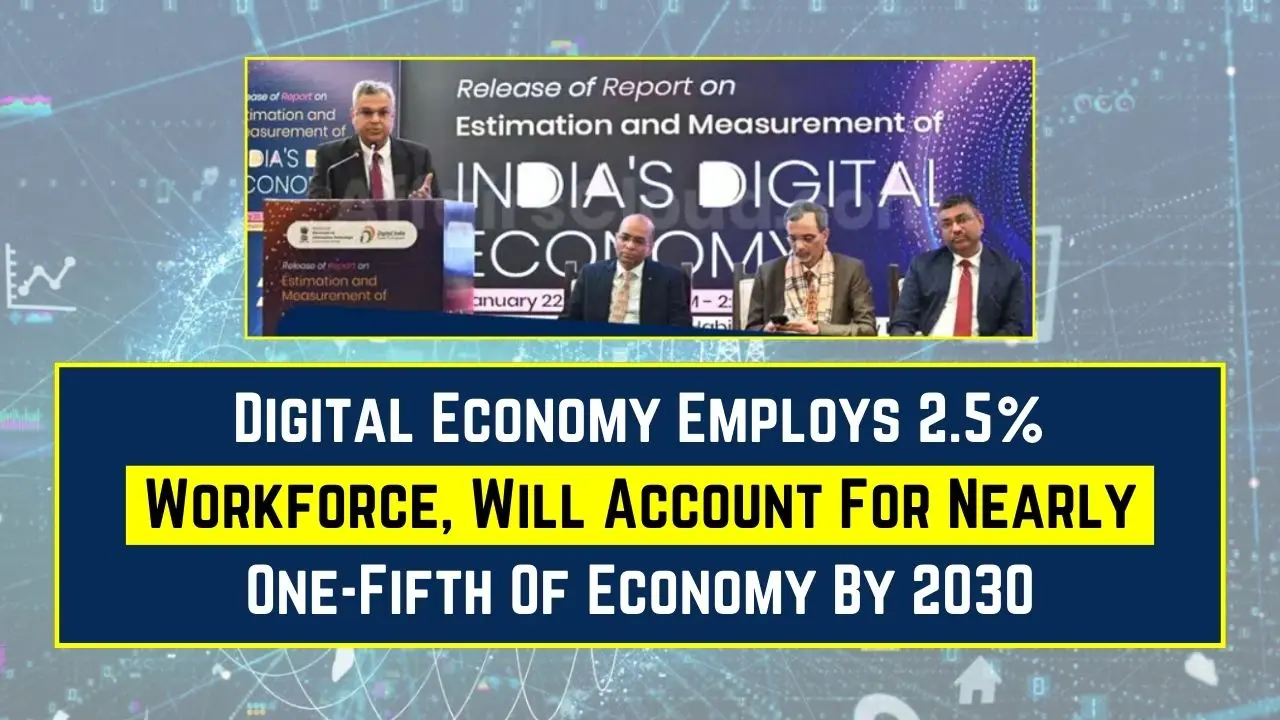India’s Digital Economy: According to government projections, India’s digital economy is expected to surpass the growth of traditional sectors and account for nearly one-fifth of the nation’s total GDP by 2030. Digital-enabling industries have expanded at a rate of 17.3% over the last ten years, which is substantially faster than the economy’s overall growth rate of 11.8%.
- By 2029-2030, the digital economy in India is predicted to grow at a rate nearly twice as fast as the country’s overall economy and account for nearly one-fifth of the country’s income. This indicates that the country’s digital economy will surpass both manufacturing and agriculture in less than six years.
- The expansion of digital platforms and intermediaries is anticipated to generate the greatest growth in the near future, followed by increased digital diffusion and the digitalization of the rest of the economy.

- According to the report, this will eventually reduce the proportion of ICT industries that enable digitalization in the digital economy.
- Particularly digital platforms have grown quickly, and in the upcoming years, they are expected to grow at a rate of about 30%.
- As per the report, India ranks third globally in terms of economy-wide digitalization and 12th among G20 nations in terms of individual user digitalization, according to the IT Ministry. With 11.74% of the country’s GDP (Rs 31.64 lakh crore, or $402 billion) coming from the digital sector in 2022-2023, India’s economy has grown significantly.
Future Forecasts: The GVA Share of the Digital Economy
The core digitally enabling industries, which include ICT services and the production of computers, communication devices, and electronic components, accounted for 7.83% of GVA (Gross Value Added), with digital platforms and intermediaries contributing an additional 2%.
- Additionally, digitalization contributed 2% of GVA to traditional industries like retail, education, and BFSI, demonstrating the widespread influence of digital transformation.
- By 2029-2030, the digital economy is expected to surpass manufacturing and agriculture in terms of its share of gross value added (GVA), reaching 20%.
- Rapid AI adoption, cloud services, and the emergence of global capability centers (GCCs), of which 55% are located in India, are important growth drivers.
- India’s digital economy plays a significant role in employment and economic growth, empowering women in the workforce and opening up new opportunities in a variety of industries.
- According to the ministry, the swift growth of digital platforms portends a continuous shift that will influence the nature of work in India in the future.
Don’t Miss Out: Earn ₹191.75 monthly Tax-free income from TFSA- Check Unlock Process
Traditional sector’s digitalization
Interesting facts regarding the various sectors’ digitalization and their contribution to businesses’ revenue were brought to light by the primary survey and stakeholder discussions. Businesses are not all digitalizing in the same way. For instance, compared to wholesale sales, retail sales are significantly more digitalized. Businesses are also spending money on digital strategies for expanding their clientele and expanding their operations. According to MeitY, chatbots are fairly commonplace.
- Although more than 95% of banking payment transactions in the BFSI sector is made online, revenue-generating activities such as loans and investments are still mostly conducted offline, and financial services as a whole are less digitalized.
- E-tailers are opening physical stores, retail is moving to omni-channel models, and digital inventory tools and AI chatbots are increasing productivity.
- Offline, online, and hybrid models have all been adopted in education; the majority of institutions prefer hybrid approaches.
- While larger companies are fully digitizing their operations, smaller players are falling behind as the hospitality and logistics industries embrace AI, the metaverse, and digital tools.
The biggest GitHub AI contributor
- According to the report, India now ranks third in terms of the number of domestic unicorns and is the biggest contributor to the global GitHub AI project. Developers can store, share, and work together on code, webpages, and other types of content using the GitHub online platform.
- According to the report, India contributes more to GitHub for AI projects than any other country in the world (23%), with the United States coming in second at 14%. After China and the United States, India had the third-highest number of domestic unicorns as of April 2024.
- The report states that cloud services and global capability centers (GCCs) are the areas of India’s digital economy that are expanding at the fastest rates. India’s public cloud market is anticipated to expand at a 24% compound annual growth rate (CAGR) due to the growing adoption of AI, reaching $20.3 billion by 2027.
- Multinational firms set up offshore facilities known as Global Capability Centers (GCCs) to offer a range of services to their parent companies.
- In India, GCCs offer services like business process management, IT support, and research and development. India is home to 55% of the GCC countries worldwide; its population is expected to rise from 1,250 in 2017–19 to 1,900 in 2023–25.
- According to the report, the information and communication technology (ICT) sector in particular, computer-related services contributes significantly to this growth, with these businesses making up 6% of the total output of computer-related services.
Maximum Social Security Benefits at Ages 62, 67 and 70
WestJet Class Action Settlement: Here’s your chance to Claim the share of $12.5 million settlement!
Why is quantification necessary?
Over the past ten years, the digitalization of the Indian economy has advanced remarkably. However, no reliable and current estimates exist regarding the digital economy’s contribution to employment and national income. According to the MeitY’s statement, policymakers and the private sector must quantify and comprehend how the digital economy propels economic growth, employment, and sustainable development.
- Based on a globally recognized framework, this report attempts to gather the first collection of reliable, understandable, and up-to-date estimates of India’s digital economy. “Policymakers, companies, and other stakeholders can benefit greatly from the insights presented in this report,” Meity stated.
- It is anticipated that precise information about the digital economy will facilitate better policy choices, allowing for focused investments and interventions to promote digital expansion. Businesses can boost competitiveness in a globalized market, spur innovation, and inform strategic decisions by knowing how digital technologies contribute to their industries.
- This holds particular importance as India prepares to introduce the Budget 2025-2026 to Parliament on February 1. An annual financial statement detailing anticipated government spending and revenue for a given year is called the Union Budget.
